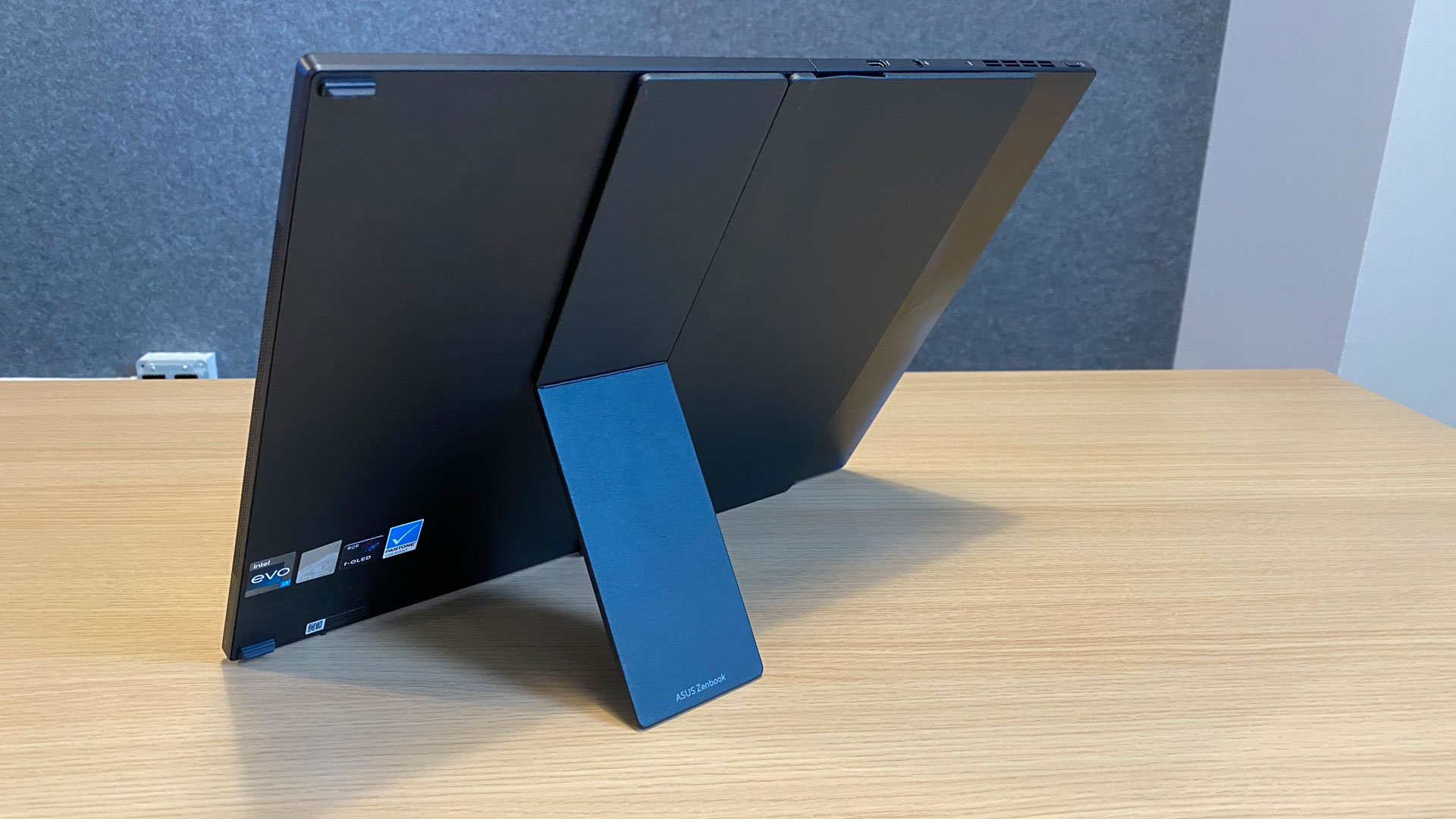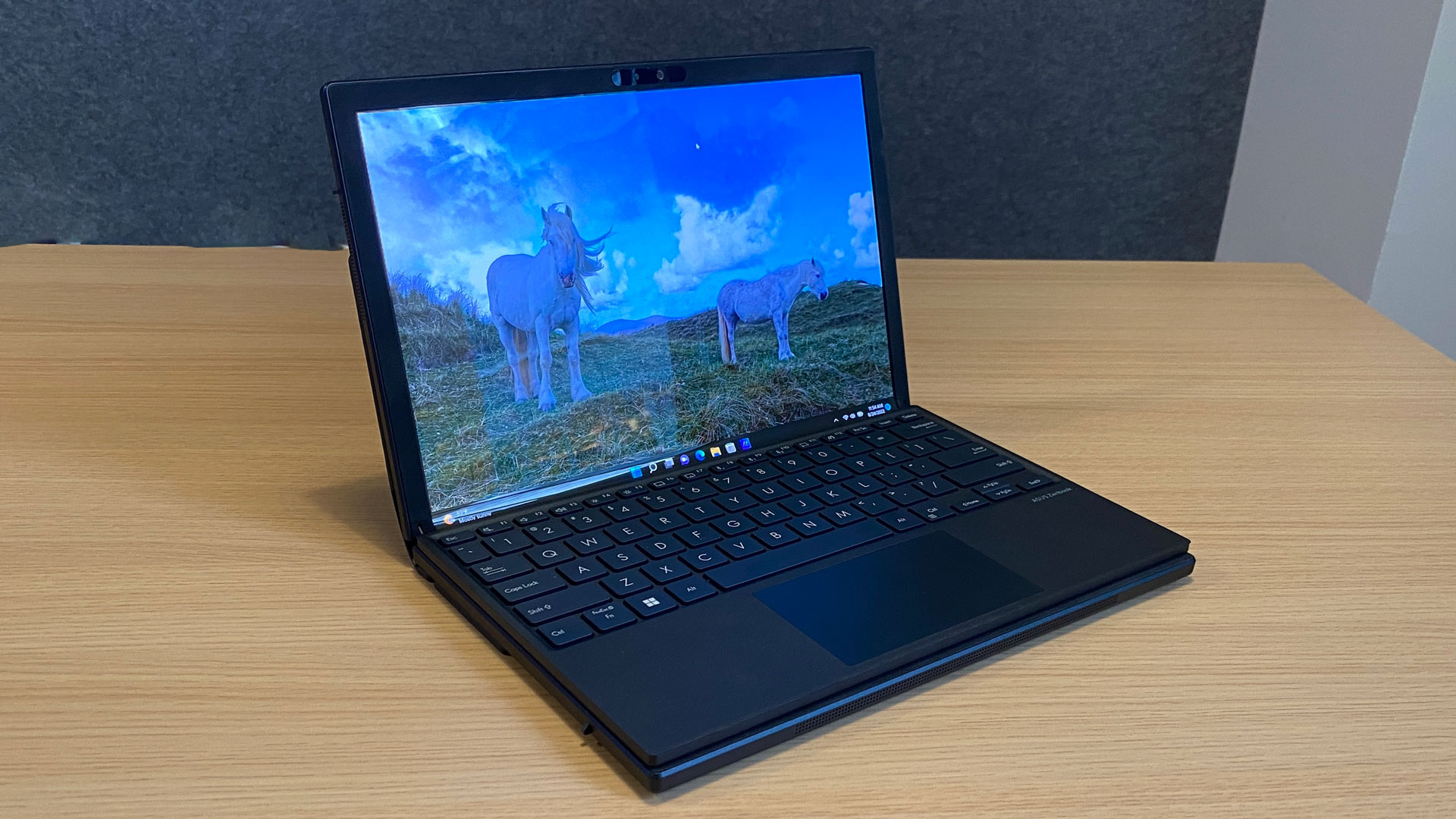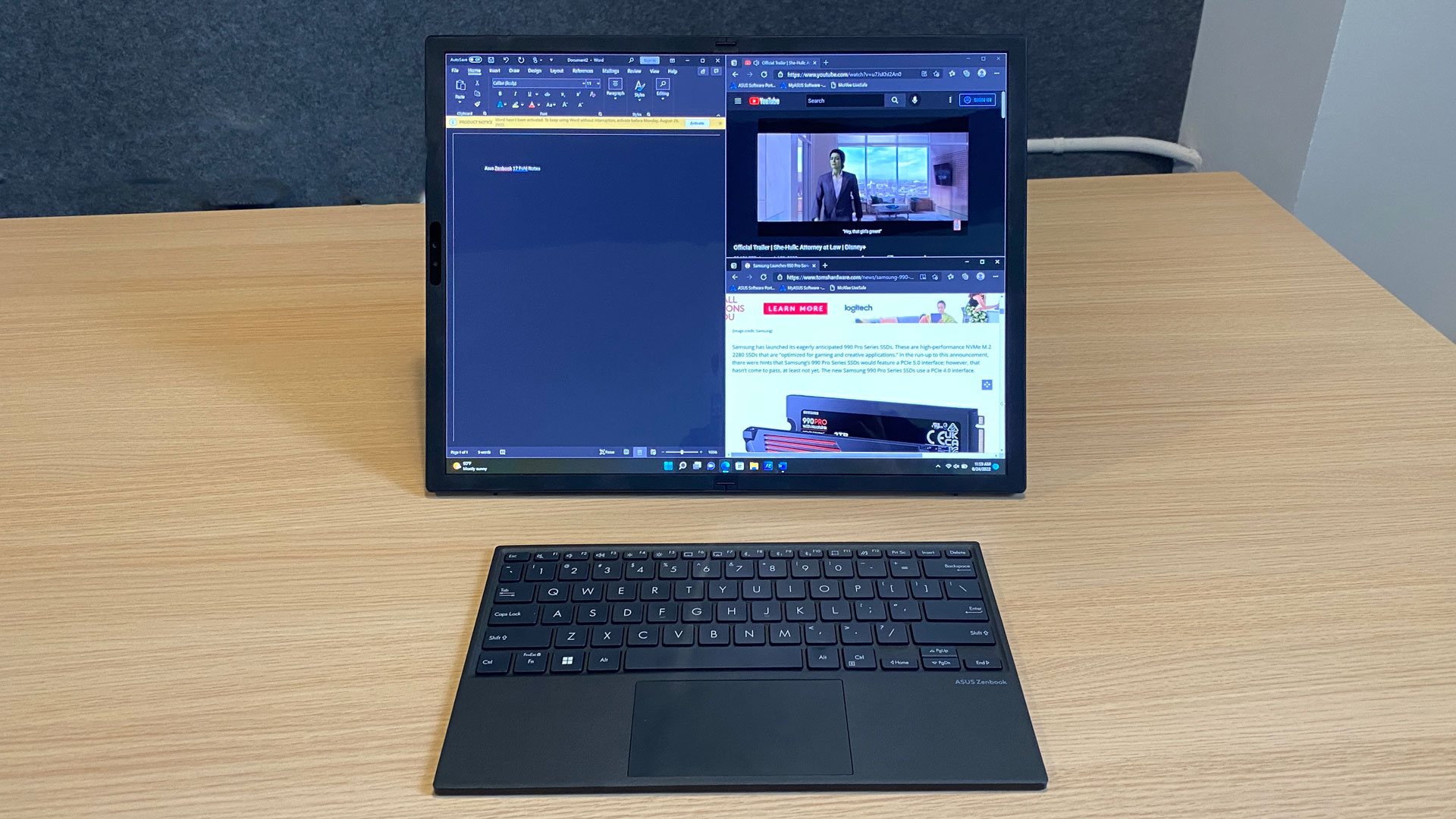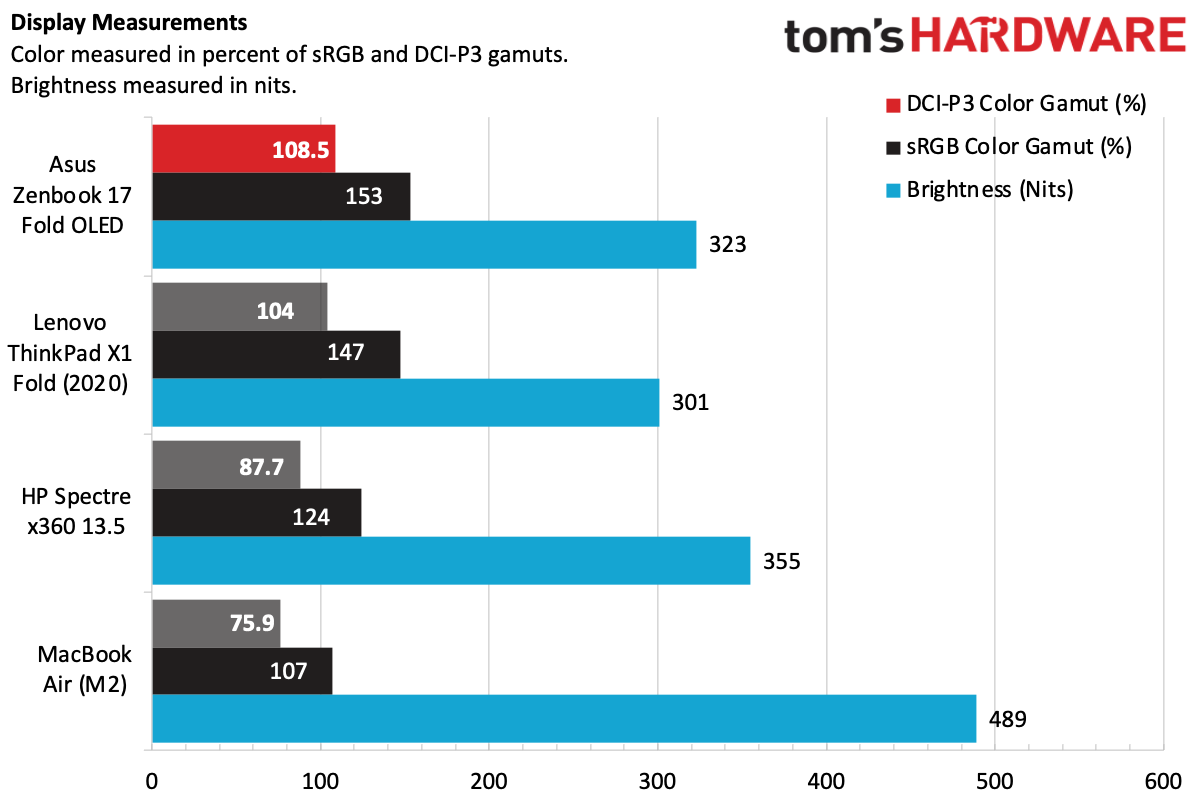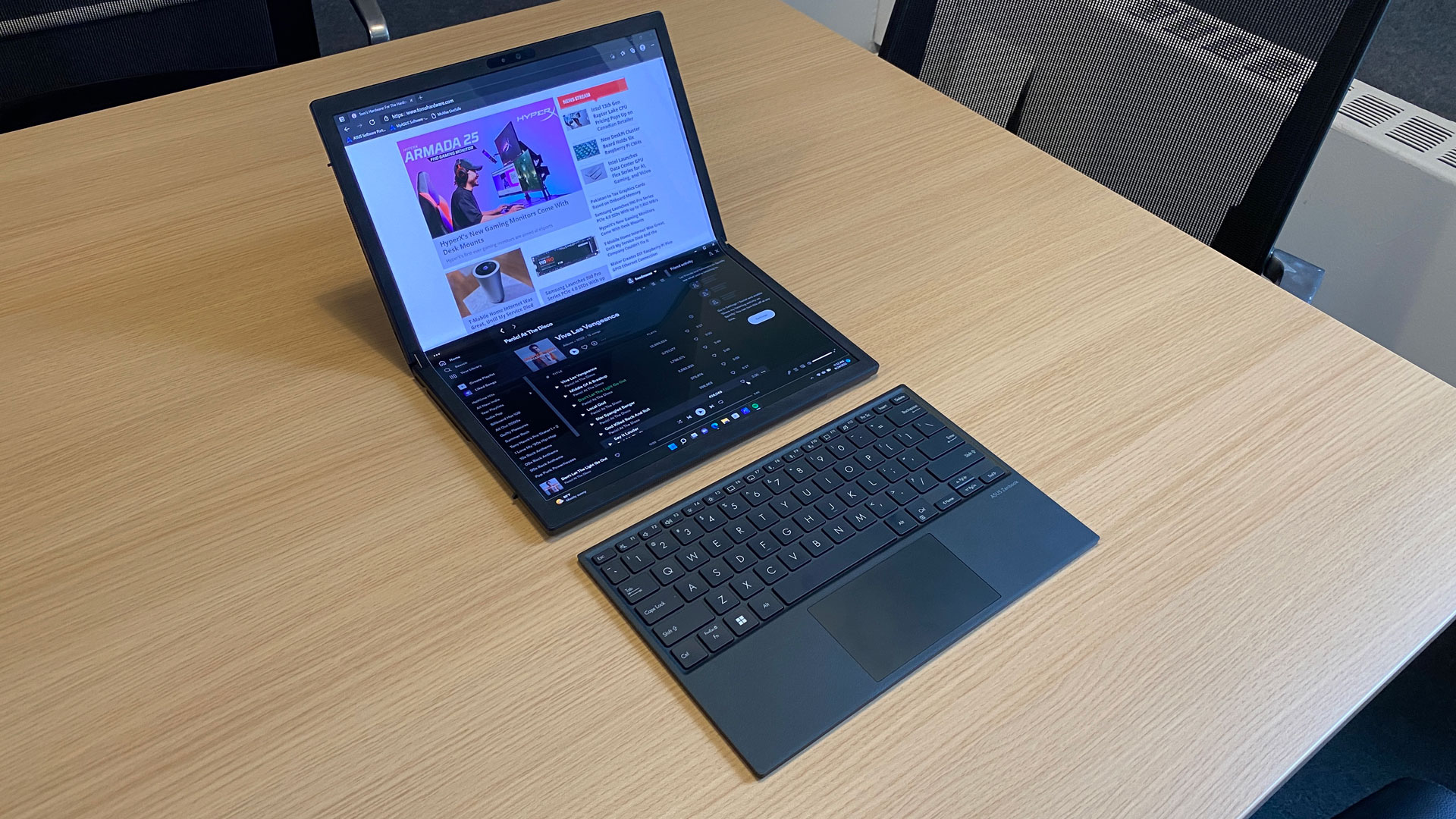Tom's Hardware Verdict
The Asus Zenbook 17 Fold OLED is the biggest foldable we've seen yet, which makes for great monitor modes and a usable laptop mode. But it's still very expensive and a bit clunky.
Pros
- +
Big, beautiful display
- +
Included Bluetooth keyboard is comfortable
- +
Works as 12.5-inch laptop
Cons
- -
Asus warns against using a stylus
- -
Kickstand doesn't work in portrait mode
- -
Heavy when working as 12.5-inch laptop
- -
Very expensive
Why you can trust Tom's Hardware
Samsung has been releasing phones with foldable screens with a regular cadence, but laptop manufacturers have been taking their time with the technology. It's been two years since I last reviewed a foldable PC. The Asus Zenbook 17 Fold OLED ($3,499.99, shipping in Q4) is just the second to pass through our labs, but it hopes to make a big splash with sheer size.
Asus' foldable, when fully unfurled, has a 17.3-inch OLED display, and it can also be used as a 12.5-inch laptop PC with the included keyboard. Where Lenovo went small with its debut folding computer, the ThinkPad X1 Fold, Asus has upsized.
That makes for a better experience in laptop mode, and the OLED panel makes for an impressive display with the keyboard separated.
But the Zenbook 17 Fold also feels like a really big ThinkPad X1 Fold. The design is almost the same, just with a more exciting coat of paint and a growth spurt. That's not enough to bring foldable computers into the mainstream (or our list of the best ultrabooks), especially with such a large price tag, but I can see how foldable convertibles could be legitimately useful.
Design of the Asus Zenbook 17 Fold OLED
The Zenbook 17 Fold OLED is just the second foldable laptop we've seen come through our review lab, and even two years after Lenovo shipped the ThinkPad X1 Fold, there's still a sense of incredulity that a laptop can just fold in half. Sure, Samsung's phones have been doing it regularly, but I think size plays a role here; that's where Asus makes its big play. The Zenbook 17 Fold is significantly larger than the 13.3-inch ThinkPad X1 Fold.

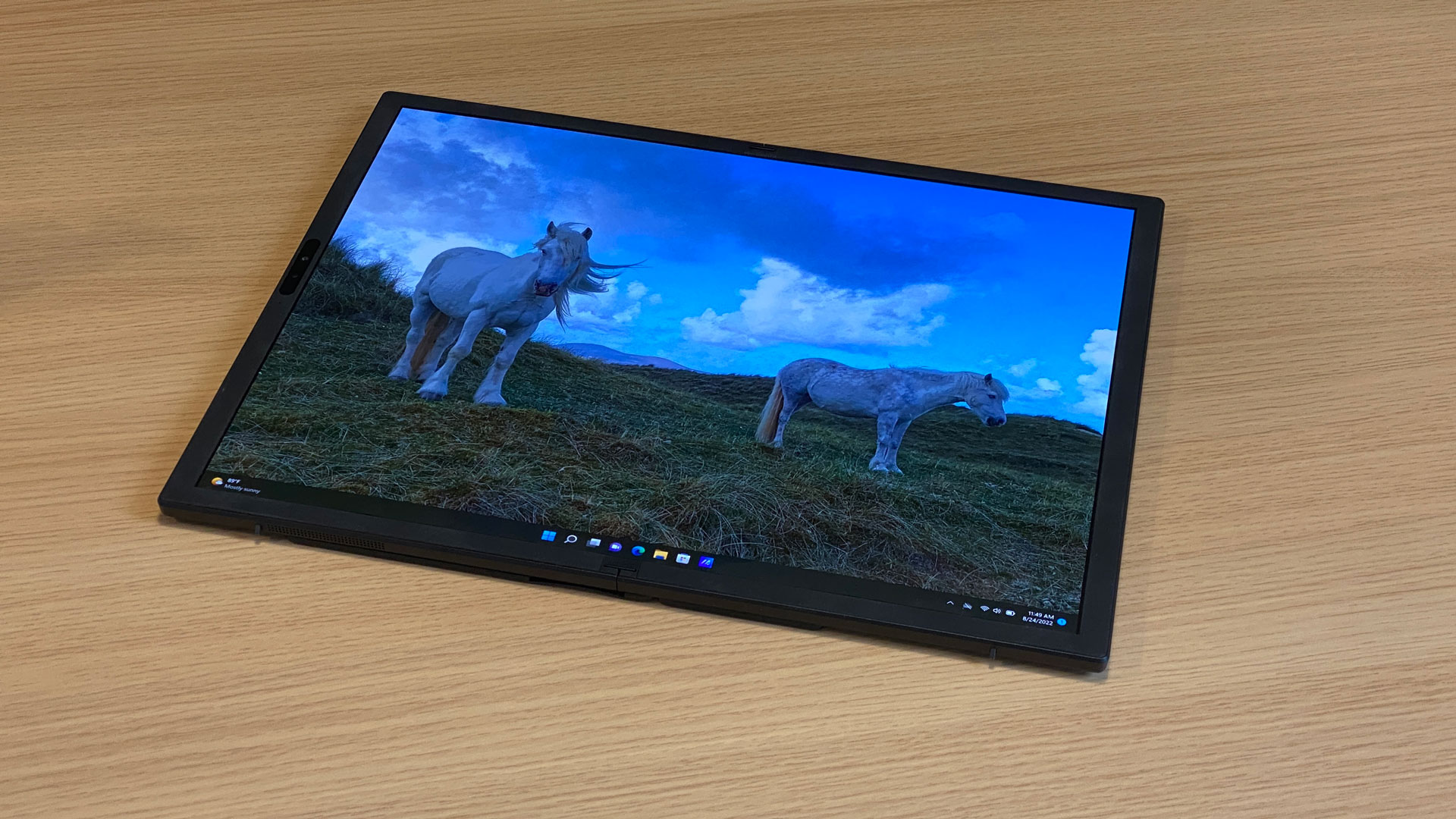
Asus' foldable ships flat and folds closed. When folded, the Zenbook 17 Fold is like a really chunky hardcover. There's a gap in between where the screen doesn't fold completely flush (you can, however, fit the included keyboard in that space). The chassis is comprised of black magnesium alloy, except for a portion of the front that has an Asus Zenbook logo on blue glass that reflects light in an interesting–albeit kind of distracting–way. It will certainly catch your eye. A greenish-gray faux leather cover wraps around the laptop's ‘spine,’ sliding as the system unfolds. This is very much how Lenovo designed the ThinkPad X1 Fold back in 2020, and I wish Asus did something more novel here, two years later.
On the very back, there's a vertical bar of faux leather, and the bottom half pops out into a kickstand, though it only works when the device is displayed in portrait mode. For landscape use, Asus includes a piece of cardboard to attach to the packaging; It's a janky work-around that I could really only use in one place. Does Asus expect people who buy this to bring the packaging everywhere?
The folding screen allows for several different use cases. There is, of course, the 17.3-inch monster tablet, which I found to be too big for handheld use, though it works while laying flat. (You could also, in theory, hold it like a book. Like a tablet, I found the Zenbook a bit unwieldy in this position in my hands.)
Asus seems to be pushing the Zenbook primarily as a mix of laptop and portable desktop. The 17.3-inch foldable OLED panel allows for a large laptop mode with Windows 11's virtual keyboard, or a 12.5-inch, 3:2 laptop when you attach the included magnetic Zenbook keyboard to the lower half of the screen. This was a major complaint with the ThinkPad X1 Fold: The smaller 13.3-inch display folded into an even smaller laptop. Here, the laptop size is more reasonable.
I still think this feels far more clunky than a regular laptop, but there is a degree of magic in taking the keyboard off, pulling out the kickstand, and then having a 17.3-inch monitor to use when you get to an office, coffee shop or airport. The bezels don't feel incredibly thick around the full 17.3-inch screen, but when used as a 12.5-inch notebook, they're noticeable and feel distinctly early 2000's.
Asus' website claims that the Zenbook's hinges are tested for 30,000 folds. On its latest foldable phones, Samsung is promising 200,000 folds, which the company suggests is 100 folds a day for five years. If that's the case, 30,000 should still be plenty for the Zenbook, as laptops are rarely abused the way phones are. Still, it would be comforting for a laptop at this price to offer more. Perhaps it's the size or weight or the laptop that means fewer folds? This sure is bigger than a smartphone.
The Zenbook Fold is 3.31 pounds (the keyboard adds an extra 0.66 pounds). Unfolded, it's 14.9 x 11.32 x 0.5 inches. While folded it's a more compact 11.32 x 7.45 x 34.5 x 1.36 inches that you can fit into a bag.
Unsurprisingly, it's bigger and heavier than the ThinkPad X1 Fold, which was 2.2 pounds and measured 11.79 x 9.29 x 0.45 inches unfolded and 9.29 x 6.23 x 1.09 inches folded. That machine had a smaller screen.
The Fold is a heavier than standard notebooks. The HP Spectre x360 13.5, a 2-in-1 convertible, is 3.01 pounds and measures 11.73 x 8.68 x 0.67 inches. The Apple MacBook Air, a clamshell, is lighter at 2.7 pounds and is 11.97 x 8.46 x 0.44 inches, making it slimmer than any dimension of the Zenbook. Asus' foldable feels heavy when you use it as a laptop.


There are a bare minimum of ports along the Zenbook's sides. Assuming you have the laptop in portrait mode unfolded, there's a headphone jack and a Thunderbolt 4 port up top, as well as the power button. The left side has a volume rocker and another Thunderbolt 4 port. (If you rotate the device into a laptop, the side with volume rocker moves to the top while the headphone jack and power button move to the right). Asus includes a USB Type-C to Type-A adapter in the box for older peripherals or storage.
Get Tom's Hardware's best news and in-depth reviews, straight to your inbox.
Asus Zenbook 17 Fold OLED Specifications
| CPU | Intel Core i7-1250U |
| Graphics | Intel Iris Xe (integrated) |
| Memory | 16GB LPDDR5-5200 |
| Storage | 1TB PCIe 4.0 NVMe M.2 SSD |
| Display | 17.3-inch, foldable 2560 x 1920 OLED touchscreen, 4:3 aspect ratio (When folded, two 12.5-inch, 1920 x 1280 screens with a 3:2 aspect ratio) |
| Networking | Intel Wi-Fi 6E AX211, Bluetooth 5.2 |
| Ports | 2x Thunderbolt 4, 3.5 mm audio jack |
| Camera | 5 megapixel camera, infrared |
| Battery | 75 Whr |
| Power Adapter | 65 W |
| Operating System | Windows 11 Pro |
| Dimensions (WxDxH) | Unfolded: 14.9 x 11.32 x 0.5 inches / 378.5 x 287.6 x 12.9 mm |
| Folded: 11.32 x 7.45 x 34.5 x 1.36 inches / 287.6 x 189.3 x 34.5 mm | |
| Weight | 3.31 pounds / 1.5 kg Keyboard: 0.66 pounds / 0.3 kg |
| Price (as configured) | $3,499.99 |
Productivity Performance on the Asus Zenbook 17 Fold OLED
As a foldable PC, the Zenbook 17 Fold OLED has a lot to prove. It's using an Intel Core i7-1250U, along with 16GB of LPDDR5 RAM and a 1TB PCIe Gen 4 SSD.
The first ever Windows foldable, the ThinkPad X1 Fold, released in 2020, used Intel's Lakefield processor, the Intel Core i5-L16G7. It may not be the fairest comparison here, but we're including it to see the leap foldables can make when using a chip meant for laptops, rather than something specifically designed to be low-power. Our other competitors are the HP Spectre x360 13.5, a convertible that uses a similar Intel Core i7-1255U, and Apple's MacBook Air with M2.
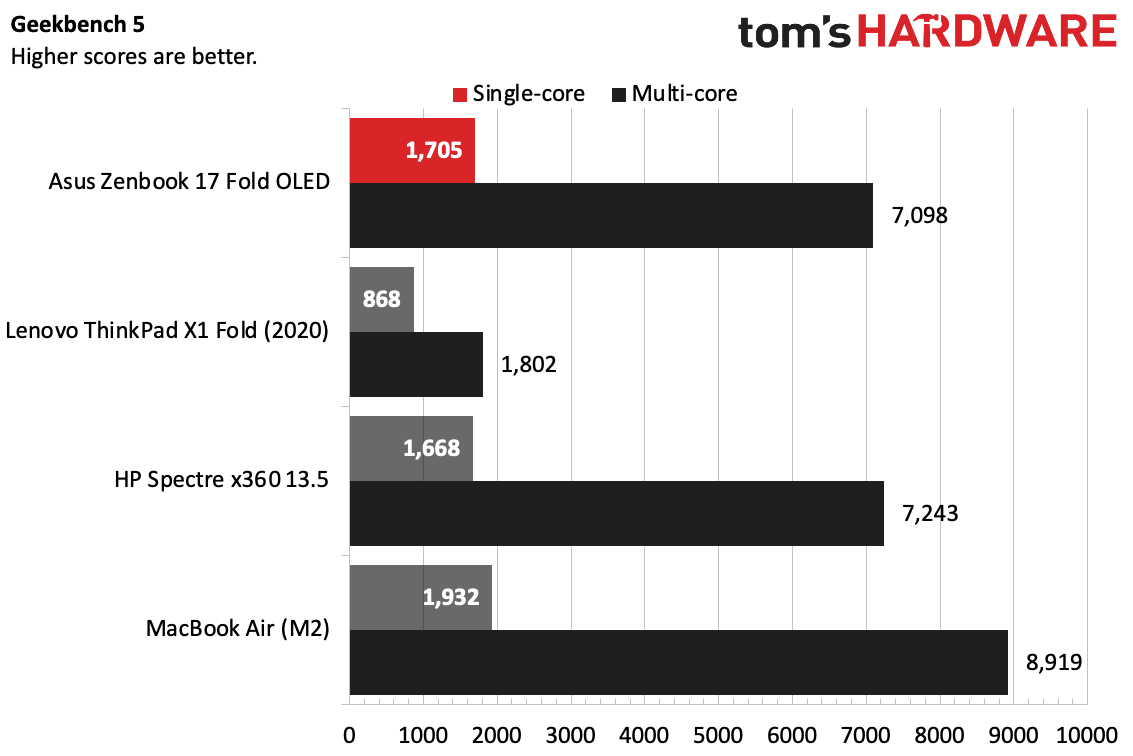
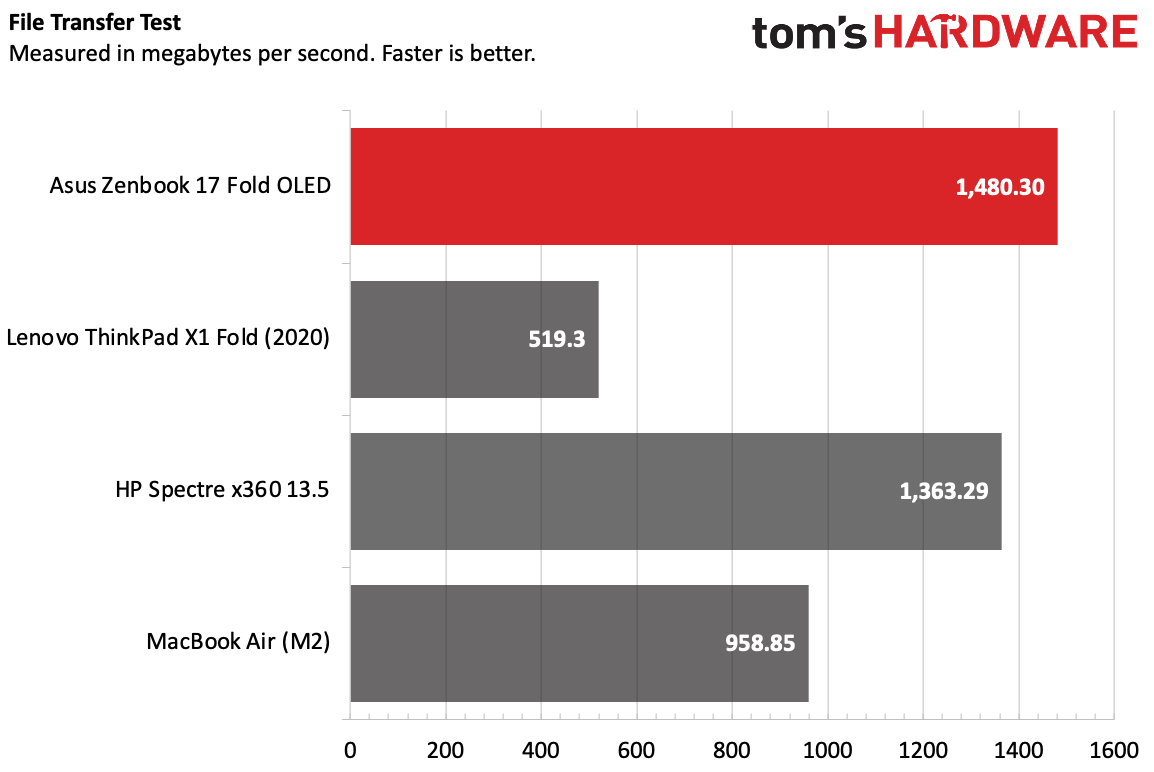
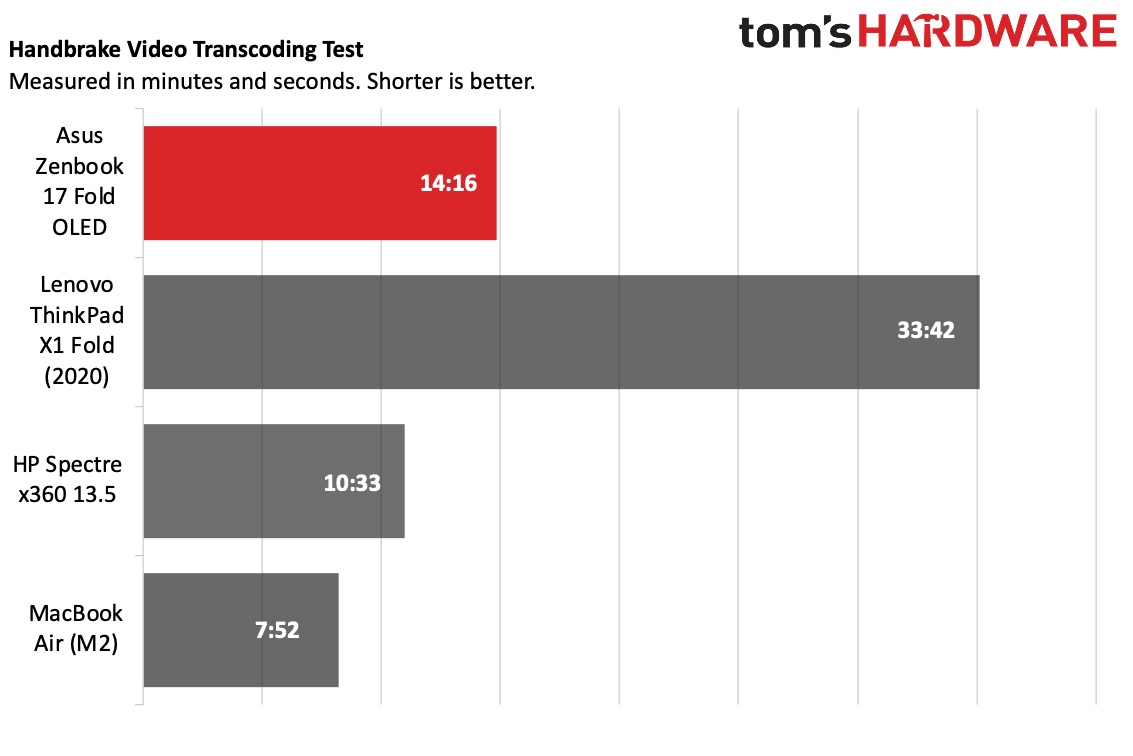
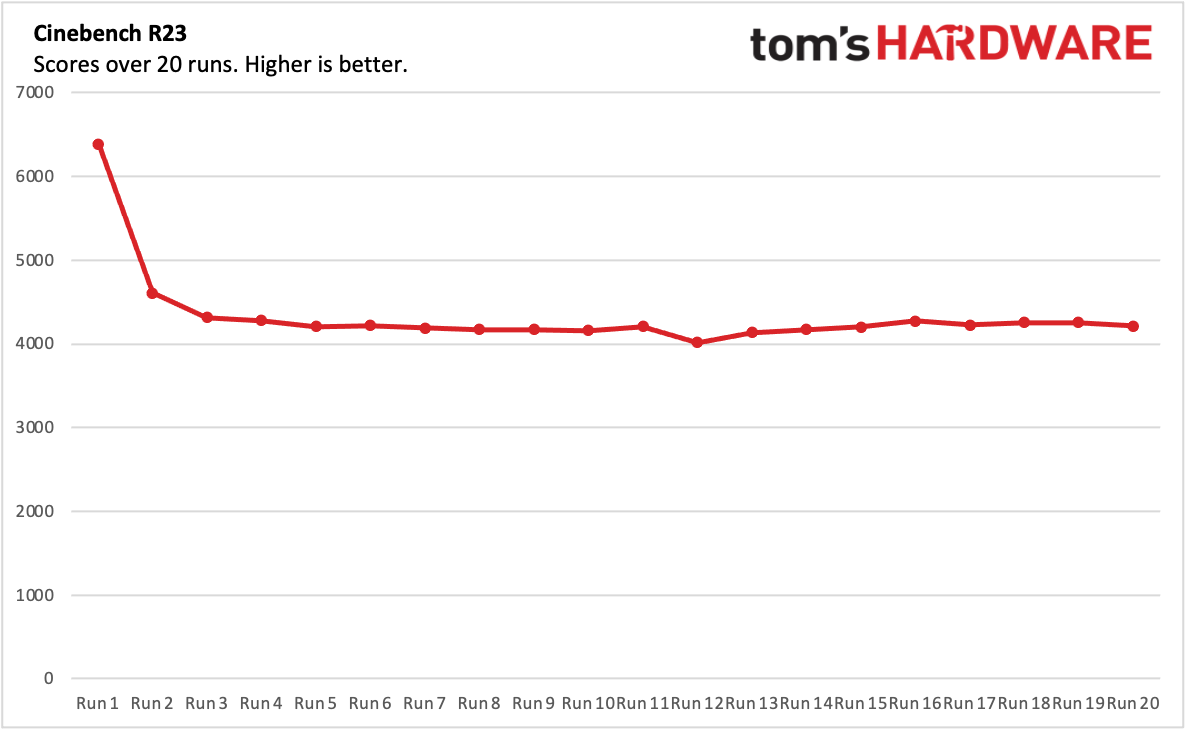
On Geekbench 5, an overall performance benchmark that leans heavily on the CPU, the Zenbook earned a single-core score of 1,705 and a multi-core score of 7,098. The HP Spectre x360 did similarly, with a single-core score of 1,668 and a multi-core score of 7,243, while the MacBook Air came out on top at 1,932 and 8,919.
This shows what using a U-series Intel chip does for the Zenbook. When the ThinkPad X1 Fold hit 868 a single-core score and notched 1,802 in multi-core, that was low even in 2020. The U-series chip can hang with a full-sized convertible.
Asus topped our file transfer test by copying 4.97GB of files at a rate of 1,480.3 MBps, beating the Spectre (1,363.29 MBps) and the MacBook Air (958.85 MBps). Faster drives have proliferated since the launch of the X1 Fold, which looks clunky in comparison now.
The one area where you could argue that the Zenbook faltered was on our Handbrake video transcoding test, where it took the foldable 14 minutes and 16 seconds to convert a 4K video to 1080p. The Spectre (10:33) and MacBook Air (7:52) were both faster, Apple's machine significantly so.
When the X1 Fold launched, its Handbrake time of 33:42 was slow, and that's when laptops often clocked times around 18 minutes. We've got a major increase on the Fold, but this is still where the typical design (and I'd imagine in the Spectre's case, the cooling), still helps.
We stress test laptops by running 20 loops of Cinebench R23, an intense workload, especially for most consumer-grade devices. The Zenbook 17 Fold started at a score of 6,384.19 and then dropped to 4,607.57. Afterwards, the next runs stabilized in the high 4,100's and low 4,200's.
During the Cinebench runs, the CPU's two performance cores ran at an average of 1.88 GHz and the eight efficiency cores ran at 1.3 GHz. The CPU package measured at an average of 59.64 degrees Celsius.
Display on the Asus Zenbook 17 Fold OLED
You can't have a 17-inch foldable OLED laptop without sticking the landing on the display. Asus has, to a degree, but there are clear improvements to be made. This display was made by BOE (a Chinese manufacturing company, not your local board of education).
For one, the screen is beautiful. When unfolded, the 17.3-inch OLED panel is bright and gorgeous. It's really nice to have this quality and quantity of screen on such a portable device. There is a crease down the middle, and while you can feel it with your finger, it's tough to see unless you get extremely close.
When you convert the Zenbook into a laptop, you get a 12.5-inch 1920 x 1280, 3:2 display on each side of the fold. With the magnetic keyboard, there's just one screen, and Windows 11 moves the task bar appropriately to accommodate it.
There's a bit of give to the Zenbook's display, which makes sense. It's flexible, after all. But Asus has a note in the fine print of the laptop's product page that gives me a bit of pause: "When using the device, please avoid using stylus or shap items to touch the display, as they might damage the display." Lenovo's ThinkPad X1 Fold, two years ago, worked with a stylus; Lenovo even sold one. I do think the effect of having a huge tablet flops a bit when you have to worry about using a stylus. I hope Asus can harden the surface of the screen in future iterations.
I asked Asus about this comment. The company wrote that "[a]ll folding screens are made from plastic, not glass, which is more sensitive to scratches and damage. Capacitive styluses (those with a rubber balloon tip) work fine and won’t damage the panel. But to avoid any confusion as to what stylus is ok and what isn’t, we prefer to play safe and officially note we don’t support any stylus."
For what it's worth, I tried using a soft-tipped stylus on our review unit and it worked, but using a free one that I got from the New York City board of elections doesn't mesh with what quality hardware could offer. You do, however, feel the components under the screen with it, even if you're being gentle.
I watched one of our test films, Tears of Steel, on the Fold. It's a 4K file, so it wasn't supported at full resolution, but I expected that the open source movie's wide range of color would wow me. I wasn't wrong. Green and pink neon holograms in a lab popped on black walls, and a sniper looking off of a bridge at sunrise had a slight orange tinge to his skin.
The Zenbook's foldable touchscreen covers 153% of the sRGB color gamut and 108.5% of the more challenging DCI-P3 space. That's a slight improvement on the ThinkPad's smaller 13.3-inch screen from 2020. The HP Spectre x360 13.5's OLED screen covered 87.7% of the DCI-P3 gamut and 124% of sRGB. Apple's Retina screen doesn't use OLED, and brought up the rear – at least when it comes to color.
At 323 nits of brightness on our light meter, the Zenbook 17 Fold beat the ThinkPad but came behind both the Spectre (355 nits) and the MacBook Air (a whopping 489 nits).
Keyboard and Touchpad on the Asus Zenbook 17 Fold OLED
The Zenbook 17 Fold comes with a Bluetooth keyboard with trackpad that looks like it was pulled off of a regular laptop. It can attach to the foldable's bezel with magnets to make it feel like, well, a typical laptop. The keys are all decently sized, and nothing seems like it was totally jammed in, with the exception of the tilde key, though it wouldn't be the first time I saw that on a small notebook.

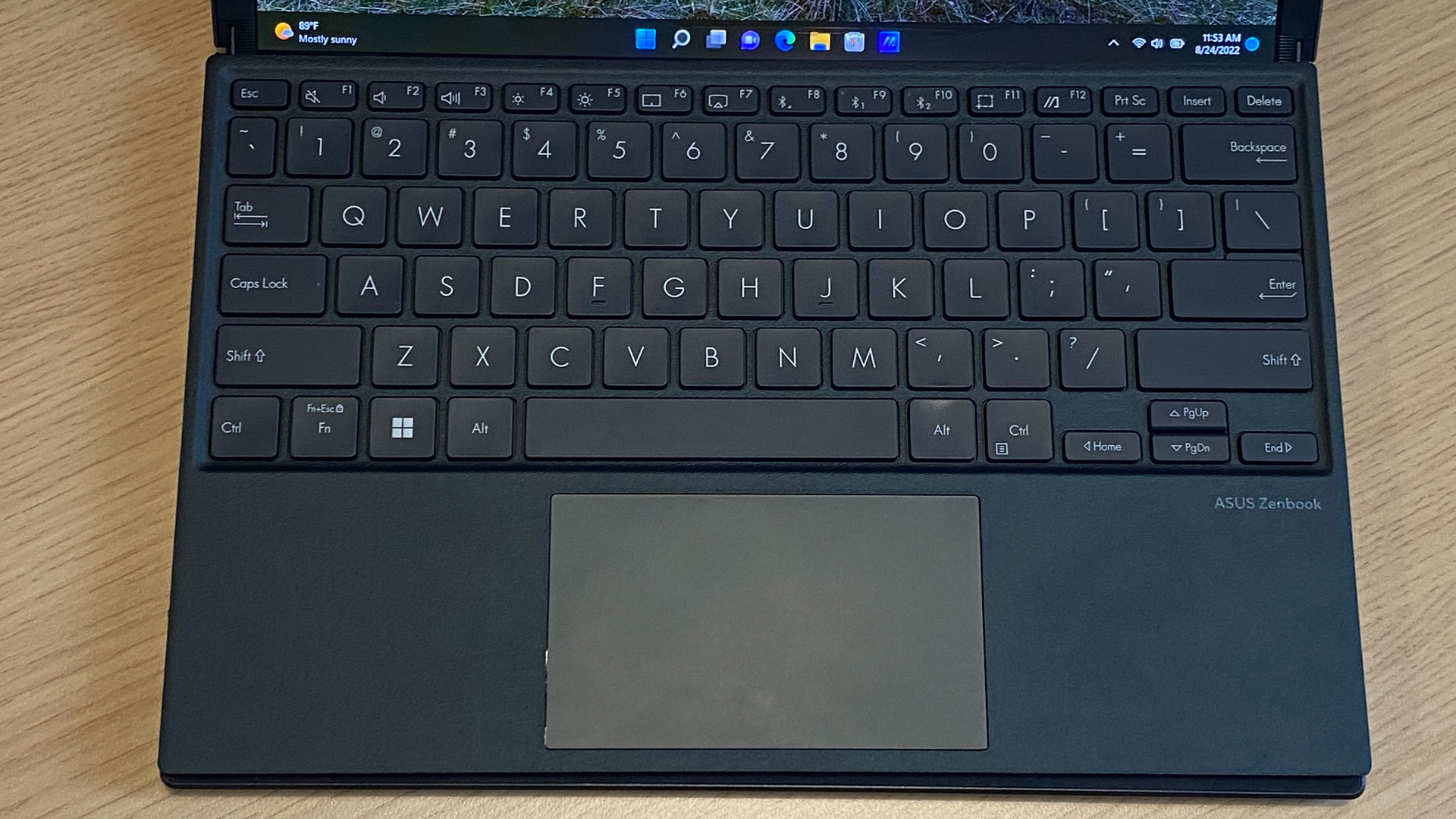
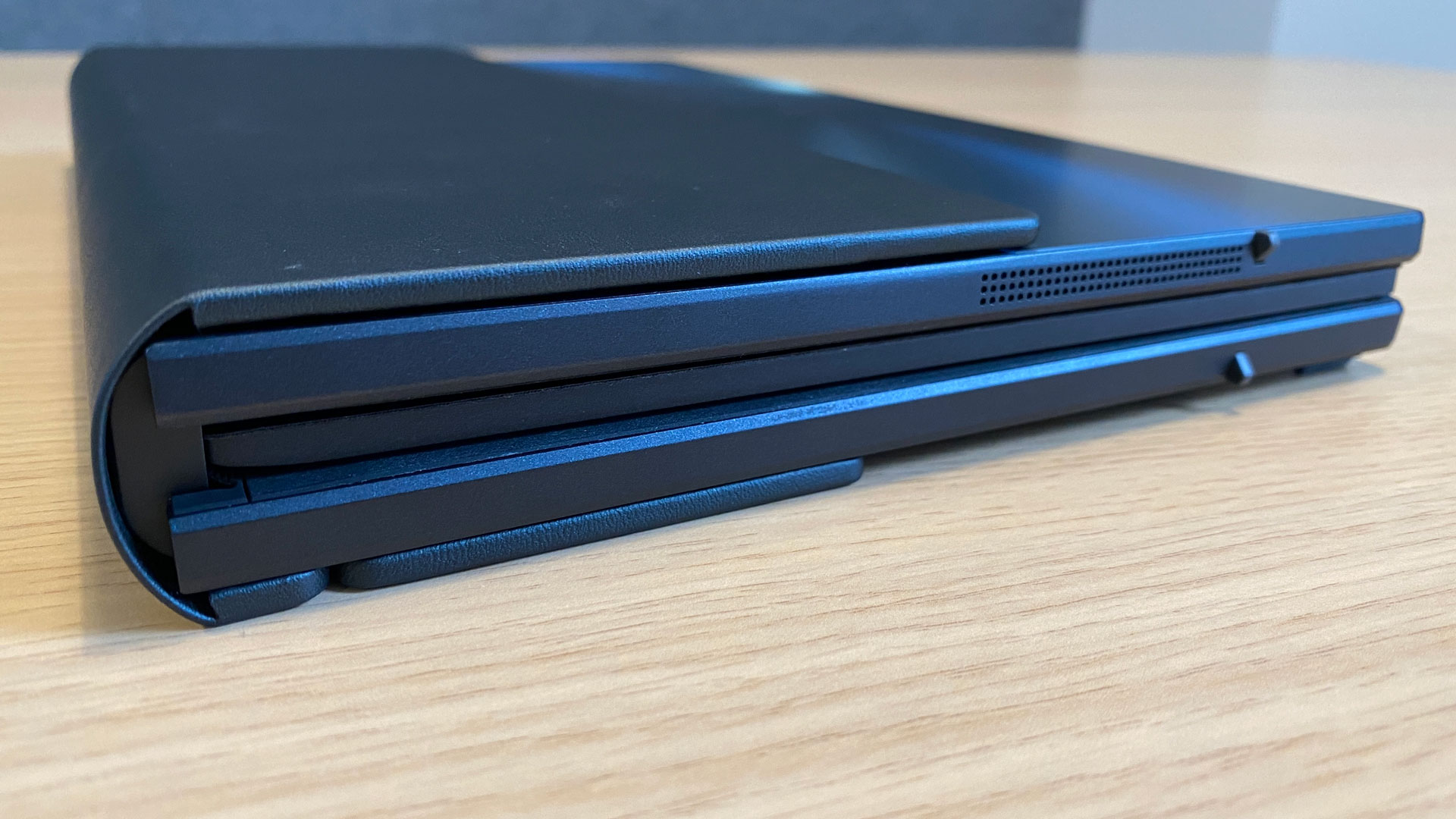
Asus claims that its keys offer 1.4 mm of travel with a 0.2-mm dish. When attached to the bottom half of the screen with magnets, the keyboard makes serious clacky noises when you type. I found it to work well enough, and I hit 118 words per minute on the monkeytype typing test. The keyboard does feel a bit elevated, but I could ultimately get used to it.
I liked using the keyboard on the device more than on my desk; it's very flat. It seems silly to use a laptop keyboard with what's effectively an all-in-one PC at your desk. I was much happier attaching other Bluetooth keyboards or my wired Keychron Q1. But if you're on the go, it's an option that works well enough.
Most laptops don't have Bluetooth keyboards. Asus has Bluetooth hotkeys to switch between multiple devices. So you could, if you wanted, also use this keyboard for your phone, for instance, or with a smart TV while sitting on your couch.
The trackpad is 2.5 x 4.1 inches, which I found to be just big enough for me. I prefer them bigger, but I really don't know where a bigger trackpad would actually gift. It's wide enough for even four-finger gestures in Windows 11, and it's nice and smooth to the touch. With the touchpad, I occasionally had issues where the cursor lagged behind my finger, seemingly due to Bluetooth issues, which didn't happen to the keyboard.
Unlike the ThinkPad X1 Fold from 2020, the Zenbook's keyboard doesn't charge wirelessly when connected to the device. There's a USB Type-C port on the keyboard's right side, next to the power switch, for charging. It's not backlit, which might be an issue for those who don't touch type . Asus claims that it lasts up to 24 hours on a charge.
Audio on the Asus Zenbook 17 Fold OLED
The speakers are an area that could use a bit of work. They get plenty of loud and easily filled up my New York City apartment with Fivio Foreign's "City of Gods."
But volume isn't everything. With out-of-the-box settings, I thought the audio was flat, with drums and synths melding into the vocals. I found that, in the Dolby Access software, I preferred the "Detailed" music setting, which distinguished the characteristics of the music. The bass, however, still wasn’t great, which is, unfortunately, par for the course on small devices.
Upgradeability on the Asus Zenbook 17 Fold OLED
Asus' design here means that users effectively can't get in. While the RAM is soldered down, Asus told me that the SSD can be changed. Asus said that getting in could damage the bezels, so users should utilize its service program to change the SSD if necessary.
Battery Life on the Asus Zenbook 17 Fold OLED
While the Zenbook 17 Fold OLED can fold up to fit in your bag, you'll want to bring a charger with you. Asus' foldable lasted for seven hours and 56 minutes on our test, which browses websites, streams video and runs OpenGL tests in the browser, all while connected to Wi-Fi and with the screen at 150 nits of brightness. It turns out a 17-inch OLED screen needs a lot of juice.
Traditional laptops with larger batteries did better here. The HP Spectre x360 13.5 ran for 10 hours and 12 minutes, while Apple's MacBook Air endured for 14:06.
Still, battery life is an upgrade over the original ThinkPad X1 Fold from 2020, which ran for 6:03 on Intel's Lakefield platform, though that was smaller with less room for a battery.
Heat on the Asus Zenbook 17 Fold OLED
We took surface temperatures while running our Cinebench R23 stress test. Our tests focused on the back of the device while unfolded.
The hottest point was on the rear of the left side of the foldable — effectively the front cover when it's closed, or the ‘lid’ of the laptop. The hottest point measured 43.3 degrees Celsius (109.94 degrees Fahrenheit).
This is not a problem when it's in laptop mode or even in display mode. But if you hold it, it's a bit toasty. The other side of the foldable was cool to the touch at 31.3 degrees Celsius (88.34 degrees Fahrenheit).
The keyboard doesn't get affected by the heat from the computer's components, because it's a totally separate device.
Webcam on the Asus Zenbook 17 Fold OLED
With the majority of the laptops I review, my problem is with the quality of the camera. Here, it's with the placement.
If you have the Zenbook 17 Fold in front of you in display mode, with the kickstand out, the camera is on the left side of the bezel. This puts you off center and looks up at you; It's not flattering at all. Ideally, some software could help with this, similar to what Apple has done on the iPad and HP has done on some laptops. (On the bright side, Windows Hello still worked in this orientation),
When you move the Fold into laptop mode, you get a much more flattering image. It's straight on, and with the right lighting, you can get decent colors (though perhaps a bit more subtle than in real life) and enough detail to look good enough on a call. But the sensor is now sideways, so your image will be in portrait mode and you'll look like you're calling in from your phone.
Me? I'd rather look like I don't know which way to hold my phone and be centered on the camera, but it's not ideal. Maybe the next generation of foldables needs two sets of webcams.
Windows 11 and Foldables
When Lenovo's ThinkPad X1 Fold shipped in 2020, it came with Windows 10, and had been meant for Windows 10X, a touch-forward version of the operating system. That got shelved, and Windows 10 never felt right on a foldable.
The Zenbook 17 Fold has the benefit of coming pre-loaded with Windows 11, which feels much better on this kind of hardware. While it's still not fully touch-oriented, Windows 11 works much better with a finger or stylus than Windows 10 ever did.
But the change with the biggest effect comes in Windows 11's snap layouts. Being able to quickly move applications to different sides or corners of the desktop makes a touch-based, foldable design far more flexible (no pun intended) to use. Asus doesn't need to layer its own software on the device for it to work. It does ship with Asus software though.
Software and Warranty on the Asus Zenbook 17 Fold OLED
Asus' suite of software consists of MyAsus, ScreenXpert and GlideX.
MyAsus is the most important of the three: It even gets a dedicated key (F12) on the keyboard. It's a massive catch-all app that checks system updates, lets you change the fan profile and make changes to everything from OLED pixel shifting (to prevent burn-in) and different color profiles. It also is stuffed with extras from partners, like trials of McAfee Live Safe and Dropbox. Yuck.
Interestingly, MyAsus has some security features that only work when the Zenbook is in laptop mode, including locking your laptop when you walk away, waking upon your return, and dimming your screen when you look away from the PC. It's unclear why Asus wouldn't provide these features in every mode, unless it has something to do with the fact that the webcam is always centered in laptop mode, which would be more accurate than in a desktop, which always has you jutted to the side.
ScreenXpert is a widget that lives on the side of the display. I find it to be of little use, as the best part — being able to quickly rearrange applications in order on screen, is built into Windows 11.
GlideX lets you use a tablet as a second screen or run mobile apps on Windows. Its features are limited unless you pay for a pro subscription (though a card with my review unit suggests that owners will get a longer trial in the box).
Asus includes a trial of McAfee LiveSafe, which also has a bookmark in the Edge browser. Beyond that, there are two more website bookmarks to pages on Asus's site to download more software. It's a bit much and cheapens the experience on this very expensive device.
Asus sells the Zenbook 17 Fold OLED with a one-year warranty.
Bottom Line
I really see where Asus was going here. The Zenbook 17 Fold OLED portends a future where instead of laptops, we all carry large foldable screens that we collapse into our backpacks. You could go to a coffee shop and open up to a big, high-resolution display without taking up the whole table. On a tray on a plane, it could be a 12.5-inch laptop. It's a computer that's literally pliable to your needs.
Asus has proven that a bigger screen makes sense here, as opposed to the 13.3-inch ThinkPad X1 Fold back in 2020, which was too small to be a good laptop. But with an extremely similar design to the X1 Fold otherwise, Asus hasn't done much to move the foldable PC forward. In fact, Windows 11 is just as big a leap forward for the foldable as the hardware. This is the most portable 17-inch PC I've ever seen, but it's also expensive, on the heavy side, and Asus is warning against a stylus on what's effectively a gigantic tablet. The Zenbook 17 Fold seems durable enough for everyday use, but we'll have to wait and see how well it holds up. For those who need something new, there are still plenty of great laptops out there. For those who want something flexible, one of our favorite laptops is the HP Spectre x360 13.5, which has its own OLED screen and can be used as a convertible tablet. As of this writing, the closest available Spectre x250 configuration to Asus’ foldable is $1,739.99, which is still far more affordable than this foldable.
Foldable PCs, effectively serving as a portable all-in-one that can fit in a typical laptop bag, may be the future of computing (or, more likely, one more popular form factor in that near future). Asus has found a better size for the flexible computer, but now it has to advance the design and make it cheaper. A $3,500 package should be durable, premium and should have no compromises. But with foldables in their infancy, there are compromises. That makes the Zenbook 17 Fold a niche device.

Andrew E. Freedman is a senior editor at Tom's Hardware focusing on laptops, desktops and gaming. He also keeps up with the latest news. A lover of all things gaming and tech, his previous work has shown up in Tom's Guide, Laptop Mag, Kotaku, PCMag and Complex, among others. Follow him on Threads @FreedmanAE and BlueSky @andrewfreedman.net. You can send him tips on Signal: andrewfreedman.01
